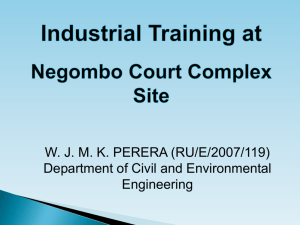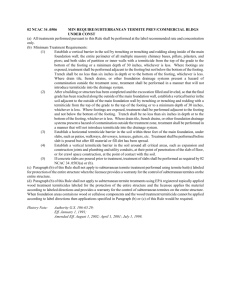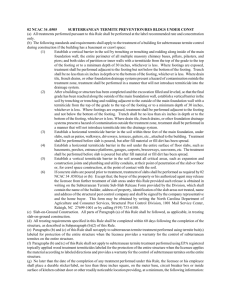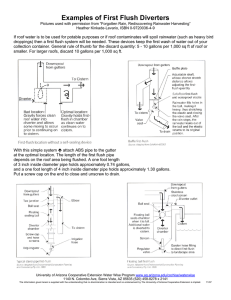L T C IQUID
advertisement
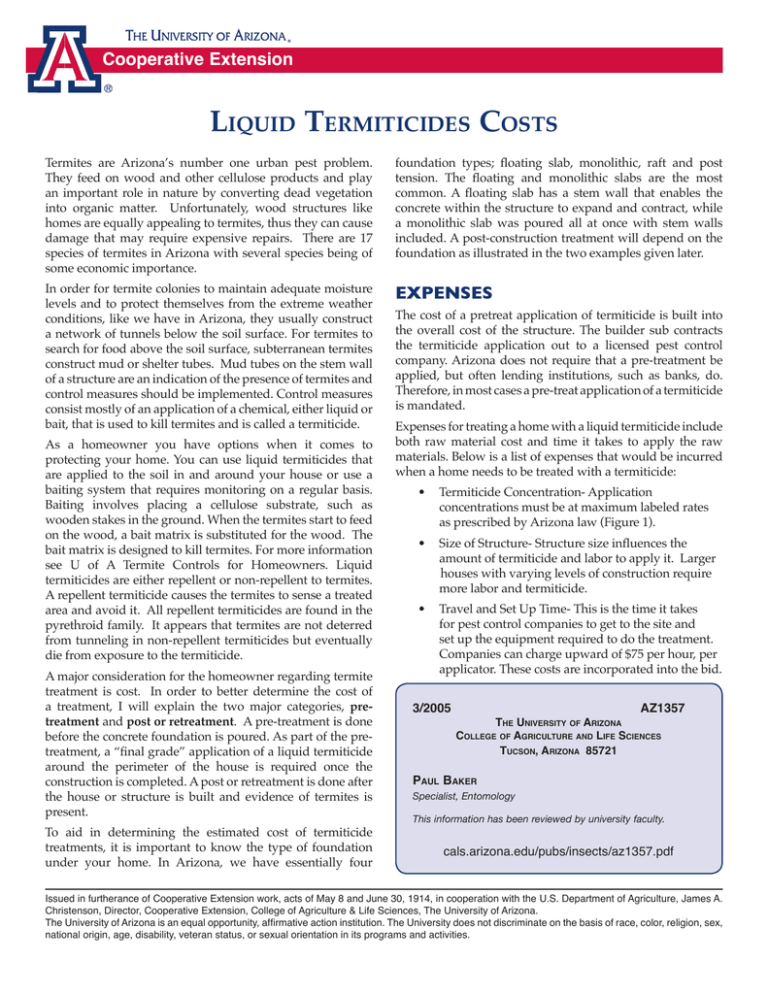
Cooperative Extension LIQUID TERMITICIDES COSTS Termites are Arizona’s number one urban pest problem. They feed on wood and other cellulose products and play an important role in nature by converting dead vegetation into organic matter. Unfortunately, wood structures like homes are equally appealing to termites, thus they can cause damage that may require expensive repairs. There are 17 species of termites in Arizona with several species being of some economic importance. foundation types; floating slab, monolithic, raft and post tension. The floating and monolithic slabs are the most common. A floating slab has a stem wall that enables the concrete within the structure to expand and contract, while a monolithic slab was poured all at once with stem walls included. A post-construction treatment will depend on the foundation as illustrated in the two examples given later. In order for termite colonies to maintain adequate moisture levels and to protect themselves from the extreme weather conditions, like we have in Arizona, they usually construct a network of tunnels below the soil surface. For termites to search for food above the soil surface, subterranean termites construct mud or shelter tubes. Mud tubes on the stem wall of a structure are an indication of the presence of termites and control measures should be implemented. Control measures consist mostly of an application of a chemical, either liquid or bait, that is used to kill termites and is called a termiticide. EXPENSES As a homeowner you have options when it comes to protecting your home. You can use liquid termiticides that are applied to the soil in and around your house or use a baiting system that requires monitoring on a regular basis. Baiting involves placing a cellulose substrate, such as wooden stakes in the ground. When the termites start to feed on the wood, a bait matrix is substituted for the wood. The bait matrix is designed to kill termites. For more information see U of A Termite Controls for Homeowners. Liquid termiticides are either repellent or non-repellent to termites. A repellent termiticide causes the termites to sense a treated area and avoid it. All repellent termiticides are found in the pyrethroid family. It appears that termites are not deterred from tunneling in non-repellent termiticides but eventually die from exposure to the termiticide. A major consideration for the homeowner regarding termite treatment is cost. In order to better determine the cost of a treatment, I will explain the two major categories, pretreatment and post or retreatment. A pre-treatment is done before the concrete foundation is poured. As part of the pretreatment, a “final grade” application of a liquid termiticide around the perimeter of the house is required once the construction is completed. A post or retreatment is done after the house or structure is built and evidence of termites is present. To aid in determining the estimated cost of termiticide treatments, it is important to know the type of foundation under your home. In Arizona, we have essentially four The cost of a pretreat application of termiticide is built into the overall cost of the structure. The builder sub contracts the termiticide application out to a licensed pest control company. Arizona does not require that a pre-treatment be applied, but often lending institutions, such as banks, do. Therefore, in most cases a pre-treat application of a termiticide is mandated. Expenses for treating a home with a liquid termiticide include both raw material cost and time it takes to apply the raw materials. Below is a list of expenses that would be incurred when a home needs to be treated with a termiticide: • Termiticide Concentration- Application concentrations must be at maximum labeled rates as prescribed by Arizona law (Figure 1). • Size of Structure- Structure size influences the amount of termiticide and labor to apply it. Larger houses with varying levels of construction require more labor and termiticide. • Travel and Set Up Time- This is the time it takes for pest control companies to get to the site and set up the equipment required to do the treatment. Companies can charge upward of $75 per hour, per applicator. These costs are incorporated into the bid. 3/2005 AZ1357 THE UNIVERSITY OF ARIZONA COLLEGE OF AGRICULTURE AND LIFE SCIENCES TUCSON, ARIZONA 85721 PAUL BAKER Specialist, Entomology This information has been reviewed by university faculty. cals.arizona.edu/pubs/insects/az1357.pdf Issued in furtherance of Cooperative Extension work, acts of May 8 and June 30, 1914, in cooperation with the U.S. Department of Agriculture, James A. Christenson, Director, Cooperative Extension, College of Agriculture & Life Sciences, The University of Arizona. The University of Arizona is an equal opportunity, affirmative action institution. The University does not discriminate on the basis of race, color, religion, sex, national origin, age, disability, veteran status, or sexual orientation in its programs and activities. Figure 1. Pre-treat application • Trenching- The area adjacent to the stem wall is the area that should be rodded and trenched in order to inject termiticide properly around the perimeter of the structure. • Paperwork The state of Arizona requires that the pest control applicator fill out the required paper work within a limited time frame. This includes the Termite Action Report Form (TARF) that is submitted to the Structural Pest Control Commission (SPCC) for their records. The Commission has regulatory over sight of the pest control operators within the state. In order to help you, the homeowner, understand the costs associated with a termiticide application a few examples are presented. ESTIMATE OF PRE-CONSTRUCTION COSTS (floating slab) In this example, a pre-construction cost is the amount of money needed to apply a termiticide at the time of construction before the concrete foundation is poured. In order to calculate the cost of this pre-treat termite treatment we need to have some information about the chemical, the treatment rate, and the number of gallons to be used. 2 The University of Arizona Cooperative Extension For example, if we know the chemical is called “Got Ya Termites” and it is to be applied under the concrete slab at the rate of 0.06% concentration, we need to determine the number of gallons to be used along the stem wall inside and out plus under the concrete. For this example, we assume that a typical house may contain 235 linear feet around the inside of the foundation plus 2,750 square feet under concrete, including garages and porches, and 195 linear feet of final grade outside (see figure 2). The calculations are determined by adding up all distances around the inside of the foundation walls for the initial application. The areas inside the stem walls and beneath the concrete determine the under slab calculations, while the final grade calculations are determined by the linear feet around the outside of the structure when the construction is completed. What does state law require? The state of Arizona requires that all termiticides be applied at full-labeled rates, which consists of a standard application rate of 4 gallons of finished product for every 10 linear feet of stem wall. In all other slab areas- 1 gal of finished product for every 10 square feet. The “finished product” is what comes out of the spray nozzle. 20ft 20ft Patio 400 sq f t 25ft 20ft Interior house is 2,100 sq ft 30ft Interior wall 30ft 20ft 45ft Garage 400 sq f t 20ft 2 ft 20ft 3 ft Point A Figure 2. Step 1: Determine the linear feet inside the structure. For the initial pre-treat, the perimeter of the foundation inside the stem wall = 235 linear ft. Start at Point A moving clockwise, add 20, 45, 30, 25, 20, 20, 30, 20, 3, 2 and 20 for the garage = 235. You add 20 ft where the garage meets the house because it is a cold joint where 2 concrete slabs meet and the termiticide needs to be applied. Step 2: Determine the square foot under concrete by adding up all the interior square footage getting 2,750 sq ft. This is determined by 30 x 65 = 1,950 sq ft plus the garage of 20 x 20= 400 sq ft and the patio of 20 x 20 = 400 sq ft for a total of 2,750 sq ft. To determine the amount of total product needed, take the total square footage of 2,750 and divide by 10 (1 gallon per 10 sq ft) giving 275 gallons needed for the interior. Take the 235 linear ft times 4 = 940 divided by 10 gallons per linear ft = 94 gallons. Step 3: Calculate the “final grade” once the structure is completely built. The final grade termiticide application is done around the exterior of the structure. Again starting at Point A and moving clockwise, the perimeter of the foundation outside stem wall = 195 linear ft. Adding 20, 45, 30, 25, 20, 30, 20, 3 and 2= 195 linear ft. The reason the amount is smaller than the interior stem wall number is because the 20 ft where the patio abuts the house and the 20 ft along the garage is not included in the total. Using the 195 linear ft times 4= 780 divided by 10 gallons per linear ft = 78 gallons. Applications of termiticide are also made to pipe and plumbing protrusions at the rate of l linear ft per protrusion. Therefore, if 3 protrusions are noted it would add 3 gallons to the total. In summary, you need 4 quantities to determine the total number of gallons to be applied; the inside stem wall, the square foots under concrete, the outside stem wall final grade and any protrusions. 235 linear ft (stem wall) 94.0 gallons 2,750 sq ft (under concrete) 275.0 gallons 195 linear ft (outside) 78.0 gallons 3 protrusions 3.0 gallons Total 450 gallons of finished product. A termiticide such as “Got Ya Termite” Termiticide at the full-labeled rate of 0.06% concentration costs $1.40 finished product per gallon. The total cost for the termiticide treatment alone would be: Termiticide= 450 gallons X $1.40 per gallon= $630.00 The University of Arizona Cooperative Extension 3 Table 1: 2003/2004Termiticide Comparisons* Product Name D RAGNET ® SFR PRELUDE ® Ma nufacturer FM C Syngenta FM C Active I ngredient Permethri n Permethri n Chemical Class Py rethroid Signal Word Dilution Rate 2003 E ff icacy Low Rate U SDA CS AZ CS MS CS FL CS SC University HI -% pen/yrs AZ -% rem/yrs TX -%rem /yrs NE -% rem/yrs Mean of soil Tested E xtra Labeling TAL ST AR ® TC PREVAIL FT ® DEMON ® TC PREMISE ® 75 PREMISE ® 0.5 SC T ERM I DOR ® FM C Syngenta Bayer Bayer BA SF Bi fenthrin Cy permethrin Cy permethrin I mi daclopri d I mi daclopri d Fi pronil Pyrethroid Py rethroid Py rethroid Py rethroid Chloroni cotin y l Cautio n Cautio n W arni ng Cautio n W arni ng Cautio n Chloroni cotin yl Pheny l Py razole Cautio n/ L iquid Cautio n W arni ng/ Solid 1.25 gal/ 94.75 0.5% 2-4 gal/98 0.5-1.0% 1 qt/99.75 0.06% 1 gal/96 0.25% 1-2 gal/100 0.25-0.5% 4-8 WS B /100 0.05-0.1% 110-220 oz/ 100 gall ons 0.05-0.1% 0.6-1.2gal/ 1 00 .06-.125% 18+ 8 10 11 16+ 5 13 7 15+ 9 17 16+ 5 6 14+ 4 9 14 14+ 12 11 5+ 11 9 N o data 9+ 9+ 9+ 9+ 10%/3 yrs 88%/1 yr 0.84%/6 yrs 5%/3 yr s N o data N o data 0.74%/ 6yrs N o data 38%/ 3 y rs 77%/ 1 y r 0.72%/ 6yrs 27%/ 3 y rs 42%/ 3 y rs 21%/ 1 y r 0.28%/ 6yrs 2%/ 3 yrs N o data N o data 0.15%/ 6 yrs N o data .05%-40%/ 1yr 49%/ 1 y r Da ta wit hheld N o data No No No No No No No No Pest Control, Outside, Pest Control, Outside, Pest Control Outside Pest Control Outside, I nside Pest Control Outside data data data data data data data data Carpenter Ants Ants Carpets Carpets Law ns & Or n. Law ns & Or n. Fl y Control Fl y Control Odor Faint Sli ght Aromatic Faint to M oderate Sli ght soapy Faint, Va ri able Faint Faint No Odor Repellent Repellent Repellent Repellent Repell ent N on-repelle nt N on-repellent N on-repelle nt Comments *Note all products are subject to change based on either the manufacture or Environmental Protect Agency regulations Where trade names are used, no endorsement is intended, nor criticism implied of similar products not named. For further information about the products mentioned in this publication, contact the manufacturer, your local termite control professional, state regulatory agency responsible for pesticide usage, or the university cooperative extension office in your area. 4 The University of Arizona Cooperative Extension CAUTION! Pesticide recommendations in this publication are registered for use in Arizona, USA ONLY! The use of some products may not be legal in your state or country. Please check with your local county agent or regulatory official before using any pesticide mentioned in this publication. Of course, ALWAYS READ AND FOLLOW LABEL DIRECTIONS FOR SAFE USE OF ANY PESTICIDE! 20ft Perimeter Injections at 12 i nch intervals 30ft 20 ft Pati o - 400 sq ft 20ft ft I nteri or hou se i s 2450 sq ft = Trenching Interior wall 35ft 35ft 20ft 50ft Garage 600 sq ft 30ft 30ft Poi nt A 6 ft 4 ft Figure 3. This cost would be added to the labor expense a pesticide company typically charges for a set price. Time expenses could vary from 3 to 6 hours total for the completed work, thus it is estimated that the costs range between $300 and $500 per structure. The total cost for the pre-treat of this house would range between $930 and $1130. Using a less expensive termiticide can reduce raw material costs. If you were to use a product such as “Termites BE GONE “ at $0.70 per finished gallon, then the costs would be reduced. In the example above it would be 450 gallons times $0.70 equaling $315 worth of termiticide. The buyer must beware, because there are differences in performance between termiticides. See Table 1 for a listing some of the specifications of most of the current termiticides available on the market. In my experience all termiticides kill termites. However, the application technologies, concentration, length of time in the soil, environmental conditions and construction practices have the potential to compromise the efficacy of the termiticide barrier. ESTIMATES OF POST-CONSTRUCTION TREATMENT (floating slab) (figure 3) In this example, post-construction costs are estimated using a floating slab as pictured in Figure 3. Calculation: In this example, one can use a termiticide “Got Ya Termites” at a rate of 0.06%, and at a given cost of $1.48 per finished gallon of solution. To complete a full re-treat or post-construction treatment it would require rodding and trenching around the perimeter of the structure and applying the termiticide at the rate of 4 gallons of finished product per 10 linear ft. (Figure. 4). In addition, the treatment should consist of an application along the stem wall on both inside and out, plus any cold joints or grade changes in elevation such as the curb stop in the garage. In the event a small infestation is identified, in many instances only a spot treatment is needed in which a limited area adjacent to the termite infestation is treated. The University of Arizona Cooperative Extension 5 Raw Materials Cost 112 gallons X $1.34/gallon =$150.00 Labor Min $75/hr =$750.00 Estimated Total Cost = $900.00 In summary, termiticides are chemicals designed to protect structures. In order for the homeowner to be better informed, it’s important to understand how the costs of a liquid termiticide treatment are arrived at and how much you can expect to pay as a homeowner. It is also important to recall that these costs are subject to change. As product and labor costs increase, the cost of protecting your home will increase. REFERENCES Kramer, Richard. Pest Control Technology. pg. 94. Feb. 2001. Figure 4. Post-treatment application In this example, to determine the amount needed for trenching and rodding, we add up all the outside linear feet around the perimeter and it is 260 ft. To get 260 start at Point A, move clockwise and add up the numbers (30, 50, 35, 30, 20, 20, 35, 30, 4, 6 = 260). Using the same figure, we add up the all the interior dimensions for a total of 280. Starting a Point A (30, 50, 35, 30, 20, 20, 35, 30, 4, 6, 20 (garage) = 280). Thus add the 260 and the 280 for a total of 540 times 4 = 2160 divided by 10 = 216 gallons of finished product. Raw Materials Cost 216 gallons X $1.48/gallon = $320.00 Labor Min$75/hr =$750.00 Estimated Total Cost =$1070.00 ESTIMATES OF POST-CONSTRUCTION TREATMENT (monolithic slab) (figure 5) In this example, post-construction costs are estimated using a monolithic slab as pictured in Figure 5. Calculation Example: Termiticide “Got Ya Termites” @ 0.06%, given the cost of $1.34 per finished gallon of solution. Because this is a monolithic foundation with no joints to be drilled the application of termiticide is to the exterior only. To determine the amount for trenching add up the linear feet around the outside perimeter of the house, which, in this example, is 260 ft. (see previous calculations). To protect the joints between the patio and house, an additional 20 linear ft should be drilled. Add the total linear ft of 260 and 20 = 280 linear ft. Multiply 280 by 4 (for the 4 gallons per 10 linear ft) = 1120, divide by 10 = 112 gallons of finished product is needed for the application. 6 The University of Arizona Cooperative Extension Perimeter Injections at 12 inch intervals 20ft 30ft 20 ft Pati o - 400 sq ft 20ft I nteri or hou se i s 2450 sq ft = Trenching Interior wall 35ft 35ft 20ft 50ft Garage 600 sq ft 30ft 30ft Poi nt A 6 ft 4 ft Figure 5. Any products, services, or organizations that are mentioned, shown, or indirectly implied in this publication do not imply endorsement by The University of Arizona. The University of Arizona Cooperative Extension 7
